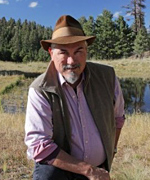 —Alan Dulaney
—Alan Dulaney
It has been a year like no other, with acrimonious partisan politics, a chaotic election cycle, a pandemic that is highly contagious, resulting in lockdowns and an economic crash. All of this will pass. Yet some problems seem to never go away. The issues with the Colorado River comprise a case in point.
Much of the Colorado River watershed has been bone dry this summer, and the U.S. Drought Monitor shows a prevalence of extreme drought conditions, especially across the upper portion of the watershed. Soil moisture levels continue to decline, and consequently runoff can be expected to be low. Streams feeding the Colorado River will see lower flows, even if winter precipitation is average (this happened in 2020).
In August, the U.S. Bureau of Reclamation released its 24-month modeling report which projects water level elevations in Lakes Powell and Mead. The projections determine how the lakes are to be operated in 2021, as specified in the 2007 shortage-sharing criteria and the Drought Contingency Plan, and thus what Arizona can expect from the Central Arizona Project canal. For 2021, no Tier 1 shortage is expected. The system has been in a Tier 0 shortage for some time, but system conservation (mostly by CAP) has staved off any cuts in deliveries.
Five-year projections are also presented, using both the historical record of flows in the river (1906-2018) and the stress test record of 1988-2018, which is more aligned with current hotter and drier conditions that produce lower natural flows. Under stress test flows, the percentage of traces (projections) showing a Tier 1 shortage rises quickly to 32% by 2022, and even higher in 2023 and beyond. Agricultural deliveries by CAP will likely have to be curtailed just as the DCP mitigation measures expire. Even under historical flows, the percentage of traces dictating a Tier 1 declared shortage rises to 23% in 2022 and 39% in 2023. A Tier 2 shortage would result in some cuts to municipal and industrial CAP customers, and under stress test hydrology, that could happen by 2023 (13% of traces). All this has been discussed in the Arizona Republic.
Arizona is responding to the challenges of the Colorado River supply. The committee which negotiated the DCP morphed into the Arizona Reconsultation Committee in June, 2020. CAP and ADWR are leading this effort, and information is being posted on the websites of both agencies:
Arizona Department of Water Resources
The ARC negotiations will be multi-level, but open and transparent and even online. Negotiations must be essentially complete by 2025 as the 2007 guidelines expire in 2026.
Pandemic and politics can rage around us, but hydrologists and water professionals must not lose sight of the importance of these negotiations, given the importance of the Colorado River.